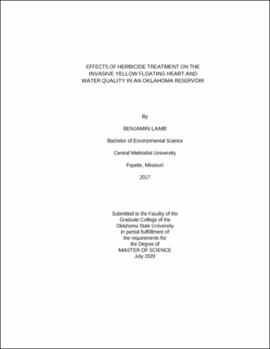| dc.contributor.advisor | Dzialowski, Andrew | |
| dc.contributor.author | Lamb, Benjamin | |
| dc.date.accessioned | 2021-02-22T22:41:16Z | |
| dc.date.available | 2021-02-22T22:41:16Z | |
| dc.date.issued | 2020-07 | |
| dc.identifier.uri | https://hdl.handle.net/11244/328655 | |
| dc.description.abstract | Effective treatment options are needed to manage and control aquatic invasive plants. Yellow floating heart (Nymphoides peltata, YFH) is an aquatic, floating leaf plant that is native to Eurasia and the Mediterranean. It successfully invaded the United States in 1882 and it was first detected in Lake Carl Blackwell (LCB), OK in 2014. It reached a peak coverage of more than 50 acres in 2019. A new reduced risk herbicide called Procellacor™ (florpyrauxifen-benzyl) was used to treat YFH in LCB in July of 2019. The major objectives of this research were to: 1) monitor the effectiveness of the herbicide treatment on YFH in an infested cove of LCB using in-situ sample plots, and 2) determine if the treatment affected water quality immediately and then for six weeks following treatment using in-situ water quality monitoring and laboratory biological oxygen demand (BOD) bioassays. It was hypothesized that Procellacor™ would cause a die off of YFH, which in turn would increase BOD and reduce dissolved oxygen (DO) concentrations in the cove. Secondary objectives included an assessment of YFH pre-treatment plant coverage distributions in relation to water depth to determine where YFH can potentially spread throughout LCB. A summarization of treatment efforts on YFH in LCB over the past three years was also developed to aid in the future management of YFH in invaded reservoirs. The coverage of YFH was reduced to 0% within four weeks after treatment. The effects of treatment on BOD and DO were generally short lived and not significant. Biological oxygen demand increased at some of the sample plots as plant decay occurred while DO concentrations increased in areas that had low concentrations before treatment, as water cycling increased. Turbidity also increased at all sites by the end of the sampling period. The results of this research suggest that Procellacor™ can effectively control YFH in a relatively large reservoir and that the post-treatment impacts to water quality are relatively minimal and short lived. | |
| dc.format | application/pdf | |
| dc.language | en_US | |
| dc.rights | Copyright is held by the author who has granted the Oklahoma State University Library the non-exclusive right to share this material in its institutional repository. Contact Digital Library Services at lib-dls@okstate.edu or 405-744-9161 for the permission policy on the use, reproduction or distribution of this material. | |
| dc.title | Effects of herbicide treatment on the invasive yellow floating heart and water quality in an Oklahoma reservoir | |
| dc.contributor.committeeMember | Stoodley, Scott | |
| dc.contributor.committeeMember | Hickman, Karen R. | |
| osu.filename | Lamb_okstate_0664M_16864.pdf | |
| osu.accesstype | Open Access | |
| dc.type.genre | Thesis | |
| dc.type.material | Text | |
| thesis.degree.discipline | Environmental Science | |
| thesis.degree.grantor | Oklahoma State University | |
